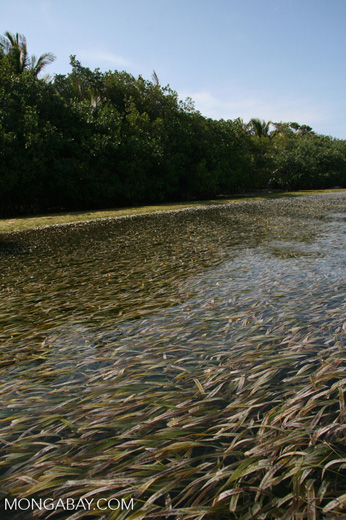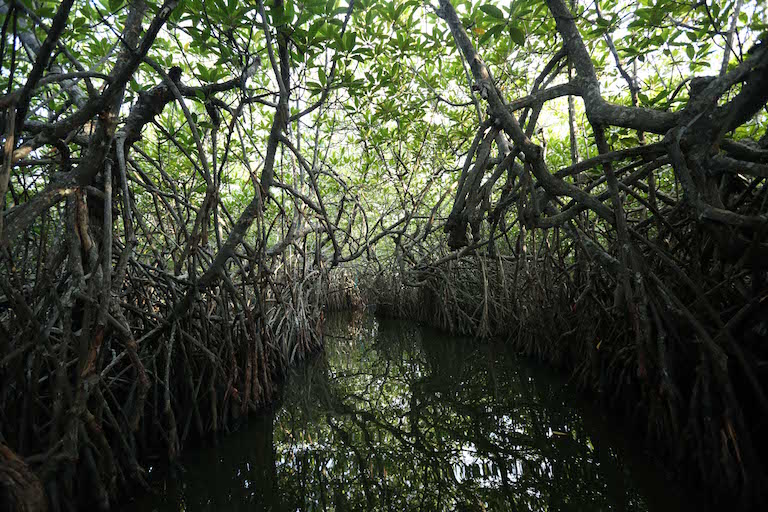- The UN Educational, Scientific and Cultural Organization (UNESCO) declared July 26, 2016, the first “International Day for the Conservation of the Mangrove Ecosystem” — aka World Mangrove Day.
- Over half of the world’s mangrove forests have been lost in the last century, many of them to aquaculture, agriculture, and development.
- The dozens of diverse mangrove species, which live in tropical and subtropical tidal flats around the world, have in common a tolerance for salt water.
- Mangrove forests provide important habitat for a diverse array of marine species and protect coasts from storms.
1. Half lost, half survive
Mangroves once covered much of the world’s tropical coastline, but half of the mangrove forests have been lost in the last half century, according to San Francisco-based conservation NGO Seacology. Forty-two percent of the 13.7 billion hectares of remaining mangroves lives in Asia, and Indonesia alone holds 20 percent of the globe’s mangrove forest cover. The archipelagic country also hosts 55 of the world’s roughly 60 to 110 mangrove species (depends who’s counting).

2. Tough trees
Mangrove trees and shrubs, found in tropical and subtropical tidal flats, are inundated with seawater twice a day. Not only can they survive waters that are 100 times saltier than what most freshwater-dependent plants can stand, mangroves provide habitat for a variety of species, from crabs to birds, and a nursery for many commercially caught fish and even octopuses. The babies of many reef fish spend months in holey wood burrowed through by marine worms.
Mangrove species derive from 20 different plant families. Their only common denominator is the salty, silty, water-logged environment they live in. So the species have come up with a variety of survival methods. Some have evolved an internal filter system to block salt from seawater from entering their root systems. Some excrete what salt seeps into their cells through salt glands in their leaves. Mangroves also have above-water roots — some of which grow skyward — that help the plants absorb oxygen.

3. Shore protectors
Mangroves offer protection against storm surges. For example, villages tucked behind mangrove thickets on the southeastern coast of India emerged unaffected from the devastating tsunami in 2004, while other villages were completely wiped out, according to observations in the journal Science.

4. Carbon sinks
The harsh, waterlogged conditions in which mangroves thrive speed up tree growth and slow decomposition of soil organic matter, making mangrove forests an excellent carbon sink. In 2015, a research from the Indonesia-based Center for International Forestry Research indicated that Indo-Pacific mangrove forests hold 6 percent more carbon than other forest stands in the region.
5. A pillar of the “Holy Trinity”
Mangrove roots act as a filter by “stabilizing the fine sediment” that runs off from land, preventing it from smothering sensitive tropical coastal coral and seagrass habitat, explained Ian Hendy, a researcher at the University of Portsmouth, England, who did his doctoral dissertation on the mangrove habitat of Wakatobi, in eastern Indonesia. In fact, the three habitats — mangroves, coral reefs, and seagrass beds — form what Hendy and other researchers often call the “holy trinity” of tropical marine environments.
6. Make way for food
Southeast Asia lost 100,000 hectares of mangroves between 2000 and 2012, according to a recent study on the drivers of mangrove deforestation. A third of this was to make way for aquaculture, though in certain regions, agriculture played a bigger role. In Indonesia, shrimp farming is the cause of 44 percent of the country’s mangrove deforestation, though what remains is still a fifth of global mangrove acreage. of Myanmar’s floodplain mangrove conversion has been for rice paddy. The researchers also cited concern that oil-palm plantation development could soon affect intact mangroves on the shores of and Indonesian Papua.

7. Make way for tourists
Even areas with relatively pristine coastal habitat are being threatened. Marine scientists in Cuba worry that the development of resorts and ports for tourism in the nearly opened country will degrade mangroves and other coastal habitats.
8. Uncertain future
Increasing global temperatures will mean a stormier future with more erratic rainfall and rising sea levels. These new conditions will be taxing even for salt-tolerant mangroves — yet people will need their protective cover more than ever.
For example, in North America, as well as other areas of the northern tropical latitudes, an increased number of storms will increase the need for protective mangroves. At the same time, in places like the Mississippi River Delta, which has one of the highest rate of sea level rise in the world, mangroves are likely to die off due to prolonged exposure to salt water. The only way mangroves there will survive is if they move inland.

9. Bright spots
Recognizing mangroves’ importance to people as well as the environment at large, conservationists are increasingly focusing on mangrove protection and reforestation. The government of Sri Lanka has committed to protecting all the country’s mangrove forests.
And, for example, in Sri Lanka and Indonesia the NGOs Seacology and Wetlands International have linked mangrove replanting and conservation projects to microloans. In this incentive system, villagers help plant coastal thickets. And if they can keep the patches alive for two years, the NGOs forgive their loans. Not only does this mean less potential damage from coastal storms, it also means villagers have access to cash to buy cows and goats and start small businesses.

Citations
- Hendy, I.W., Michie, L., Taylor, B.W. (2014). Habitat creation and biodiversity maintenance in mangrove forests: teredinid bivalves as ecosystem engineers. PeerJ 2:e591.
- Hendy, I., Eme, J., Dabruzzi, T.F., Nembhard, R.V., Cragg, C and Bennett, W.A. (2013). Dartfish use teredinid tunnels in fallen mangrove wood as a low-tide refuge. Marine Ecology Progress Series 486: 237-245.
- Murdiyarso, D., Purbopuspito, J., Kauffman, J.B., Sasmito, S.D., Donato, D.C., Manuri, S., Krinawati, H., Sartji, T., Kurnianto, S. (2015). The potential of Indonesian mangrove forests for global climate change mitigation. Nature Climate Change 5: 1089–1092.
- Danielsen, F., Sørensen, M.K., Olwig, M.F., Selvam, V., Parish, F., Burgess, N.D., Hiraishi, T., Karunagaran, V.M., Rasmussen, M.S., Hansen, L.B., Quarto, A., Suryadiputra, N. (2005).The Asian Tsunami: A Protective Role for Coastal Vegetation. Science 310(5748): 643.
- Richards, D.R., Friess, D.A. (2015). Rates and drivers of mangrove deforestation in Southeast Asia, 2000–2012. Proceedings of the National Academy of Sciences 113(2): 344-349.
- Ward, R.D., Friess, D.A., Day, R.H., MacKenzie, R.A. (2016). Impacts of climate change on mangrove ecosystems: a region by region overview. Ecosystem Health and Sustainability 2(4):e01211.

